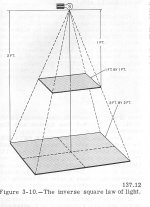Chosun Juan
Given to Fly

More light will pass through the exit pupil with the wider field of view but it will be focussed on a proportionally larger area of the retina so the light per unit area or brightness stays the same.
David
David,
Thanks for the elegant explanation. I came to this realization after prompting by Ed last time we discussed this, but couldn't quickly find the thread again, so didn't post the a-ha! moment. :brains:
Ed was starting to say some very interesting stuff about newly discovered in-between photon receptor sites or some such ..... I hope he picks up on this and continues on ..... :cat:
Apart from the actual optio-electrical physiology, I'm thinking two additional things in relation to this -- both quasi psychological .....
(i) A wider FOV (AFOV) during bright conditions (ie. The pupil is effectively stopped down smaller than the binoculars EP) will 'appear' brighter since the eye itself will add less off-axis and peripheral aberrations (astigmatism etc) -- thus giving a sharper view over more of the field which may 'appear' brighter ......
(ii) A wider FOV (AFOV) during those same conditions AND in concert with very thinly framed eyepieces may 'appear' brighter in accordance with Looksharp's PFOV hypothesis ...... (where is LS anyway? .... off for a holiday with Pompadour?? ---- can't be with Brock since the prodigal son has returned with a double Nikon barrel !!!
Thoughts by the optical mavens would be welcome .....
Ps. David - what is the significance of the 450 nm wavelength you mentioned, and what are the details and source for that information? :cat:
Chosun :gh:
Last edited:




